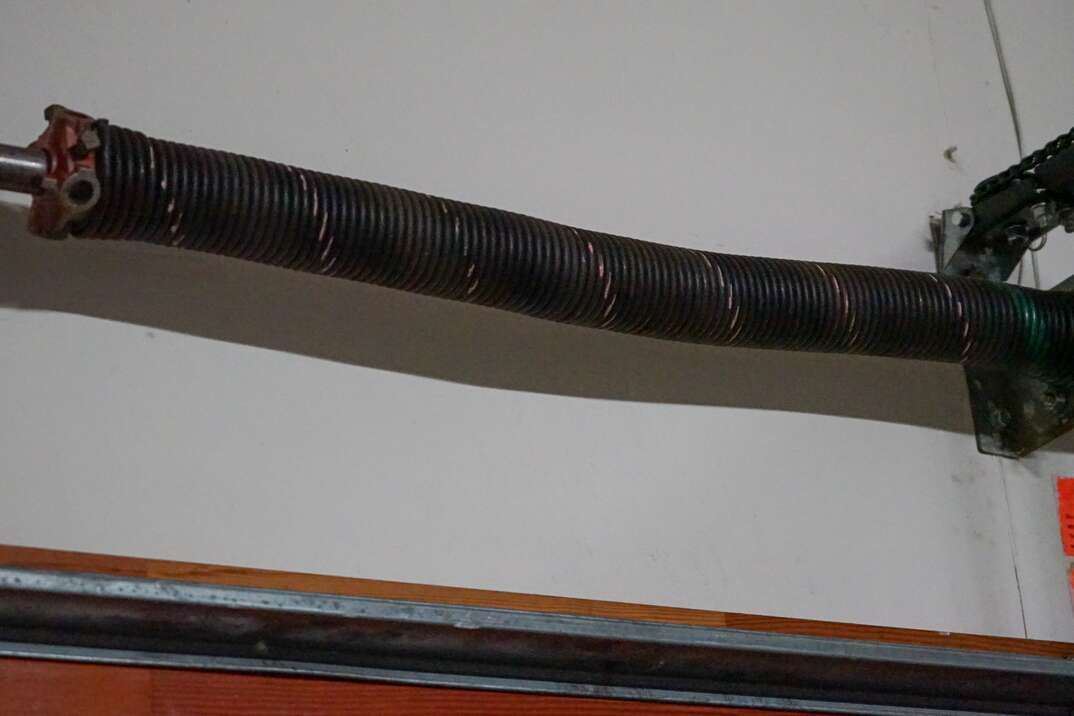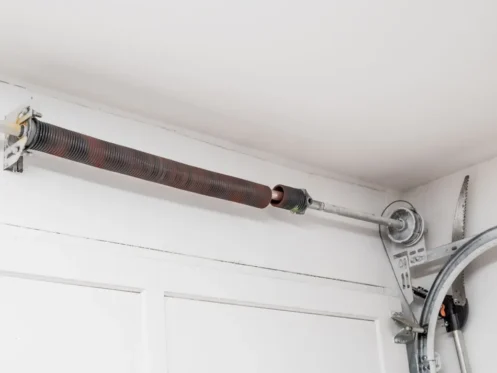A broken garage door spring can be frustrating, especially when you need access to your garage.
These springs are crucial for lifting and lowering the door, and without them, the door becomes hard to move.
While it’s important to repair the spring quickly, there are ways to open the door in the meantime.
This guide will show you how to open your garage door with a broken spring, ensure safety, and highlight the importance of prompt repairs.
How to open a garage door with a broken spring?
Key Takeaways
- Broken garage door springs can make the door difficult or impossible to open.
- It is possible to open the door manually, but extra caution is required.
- Repairing the spring should be a priority, and it’s best to call a professional to replace the spring.
What Happens When a Garage Door Spring Breaks?

A garage door spring is responsible for counterbalancing the weight of the door. It works by providing the necessary force to lift and lower the door smoothly.
There are two main types of garage door springs: torsion springs and extension springs.
- Torsion Springs: These are located above the door and twist to lift the door.
- Extension Springs: These run parallel to the tracks and stretch to provide the lifting force.
When one of these springs breaks, the door may become stuck in the open or closed position, or it may not move at all.
Without the spring working, the garage door opener or your effort cannot lift the door effectively.
Steps to Open a Garage Door with a Broken Spring
While a broken spring can make a garage door feel heavy and unresponsive, it is possible to open the door manually. Here’s how you can do it:
1. Disconnect the Garage Door Opener
First, you need to disconnect the garage door from the automatic opener.
This is usually done by pulling the emergency release cord, which is a red cord hanging from the trolley of the opener.
This will disengage the opener from the door, allowing you to operate it manually.
Tip: Before pulling the release cord, make sure there is nothing obstructing the door, and that it is not stuck in the open or closed position.
2. Lift the Door Slowly
Once the garage door opener is disconnected, you can attempt to lift the door manually.
If the door is not completely stuck and the spring is only partially broken, you might be able to lift the door with some effort.
Tip: Be cautious when lifting the door. If it’s difficult to lift or if it feels like it might fall, don’t attempt to force it open.
A broken spring means the door is heavy and might come down unexpectedly.
3. Use Support if Necessary
If the door is extremely heavy and difficult to lift, or if it doesn’t stay open once lifted, you may need to use support to keep it in the open position.
You can use a sturdy object like a broomstick or a piece of wood placed across the door and under the frame to hold it in place temporarily.
Tip: Only use the support temporarily. Do not leave the door propped open for an extended period, as the risk of it falling is high.
4. Secure the Door
Once you have the door open, make sure it is secured to prevent it from closing unexpectedly. If possible, have someone hold the door in place while you use a temporary support system.
This will help keep it stable and avoid accidents.
Safety Precautions When Dealing with a Broken Spring
Opening a garage door with a broken spring can be risky. Garage doors are heavy, and without the spring to counterbalance the weight, the door can easily fall and cause injury or damage. To avoid such hazards, it’s best to contact a trusted Kaneville IL garage door company for safe and professional repair services.
Here are some safety tips to keep in mind:
1. Don’t Attempt to Lift the Door Alone
Garage doors can weigh hundreds of pounds, especially if the spring is broken. Attempting to lift the door by yourself is dangerous, as the door may come down suddenly.
Always have someone help you if you need to lift the door manually.
2. Use Caution When Removing the Opener
When disconnecting the door from the opener, do so carefully.
If the door is not securely supported, it can drop quickly. Ensure the door is stable before attempting to remove the opener’s attachment.
3. Avoid Prolonged Use of the Manual Method
While it might be tempting to continue using the garage door manually, doing so for an extended period puts unnecessary strain on the components.
Manual operation is only a temporary solution, and the broken spring should be repaired as soon as possible.
When to Call a Professional for Garage Door Spring Repair

While opening a garage door with a broken spring is possible, it is not a long-term solution.
Garage door springs are under immense tension, and attempting to fix them without understanding how to wind a garage door spring or using the right tools can be extremely dangerous.
If you are dealing with a broken spring, it is important to call a professional garage door technician to handle the repair.
Why You Should Call a Professional:
Safety: Repairing a broken spring involves dealing with high-tension components.
If the spring is not replaced or adjusted properly, it can cause injury or damage to the garage door and surrounding areas.
Tools and Expertise: A professional technician has the right tools to safely replace the spring and ensure the garage door is properly balanced.
Long-Term Results: A technician will ensure the door operates smoothly after the repair and will inspect the system to make sure everything is functioning correctly.
How Much Does It Cost to Repair a Broken Garage Door Spring?
The cost of repairing a broken garage door spring can vary depending on factors such as the type of spring, the size of your garage door, and your location.
On average, you can expect to pay between $150 and $350 for spring repair or replacement.
- Torsion Springs: These springs tend to be more expensive to replace due to the complexity of the system. Prices for torsion spring repair typically range from $200 to $350.
- Extension Springs: Extension springs are less expensive and can usually be replaced for around $150 to $250.
It’s important to get a few quotes from professionals to ensure you are getting a fair price for the repair.
Preventing Future Garage Door Spring Issues
While springs do wear out over time, there are some steps you can take to prolong the lifespan of your garage door springs and prevent issues:
- Lubricate the Springs: Regularly lubricate the springs with a silicone-based lubricant to reduce friction and prevent premature wear.
- Check the Balance: If you notice the door isn’t operating smoothly or evenly, check the balance of the door. A misaligned door can cause strain on the springs, leading to premature failure.
- Schedule Regular Maintenance: Have a professional inspect your garage door system annually. Regular maintenance can catch small issues before they become bigger, more costly problems.
Frequently Asked Questions
1. How can I tell if my garage door spring is broken?
If your garage door isn’t opening or closing properly, makes loud noises, or the door is uneven, it could be a sign of a broken spring. Inspect the spring for visible damage or breaks.
2. Can I replace a garage door spring myself?
It is not recommended to replace a garage door spring yourself due to the high tension in the spring. It’s safer to call a professional to handle the garage door repair.
3. How long does a garage door spring typically last?
Garage door springs generally last between 7,000 and 10,000 cycles, which is equivalent to 7 to 10 years with normal use. Regular maintenance can help extend the lifespan of the springs.
Conclusion
Dealing with a broken garage door spring can be a hassle, but it doesn’t have to be a major inconvenience.
Understanding how to manually open the door and ensuring safety during the process can help you gain temporary access to your garage.
However, replacing a broken spring should be a priority, and it’s always best to consult a professional for repairs.
Regular maintenance, including lubrication and balance checks, can help prevent future issues and keep your garage door operating smoothly for years to come.

